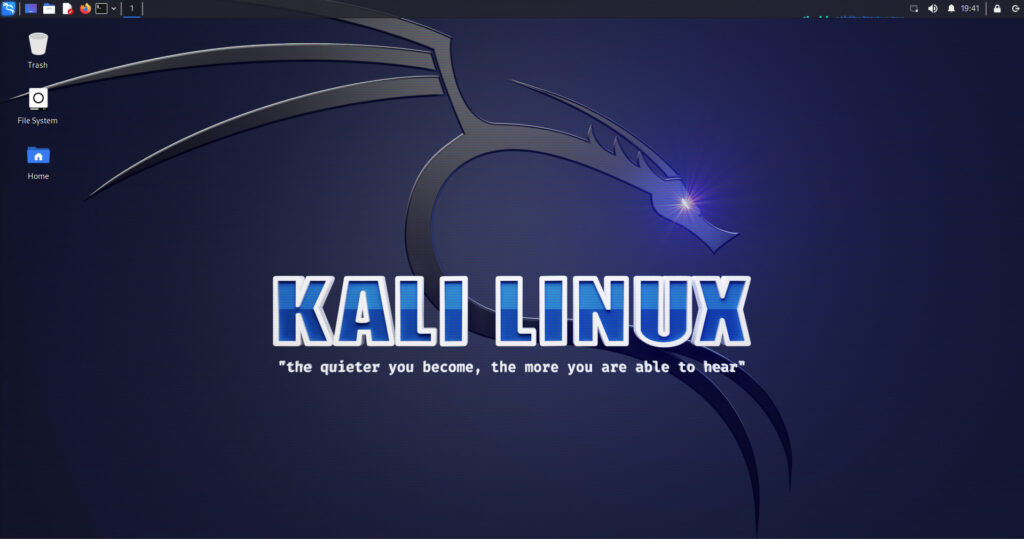Until now, I was using Kali Linux with VirtualBox, but I was thinking that I could do it with WSL2, but it seemed to be pretty good, so I'll show you how to build it. (It's pretty easy.)
We also use Win-KeX to use the GUI.
Win-KeX makes the Kali Linux GUI easy to use with WSL2 with the following features:
- Window Mode: Start the Kali Linux desktop with a dedicated window
- Seamless Mode: Sharing Windows Desktop between Windows and Kali Applications and Menu
- Enhanced Session Mode: Like Hyper-V, use RDP for a more feature-rich experience
- Sound Support
- Shared clipboard for cutting and paste support between Kali Linux and Windows
- Support for root and unprivileged sessions
- Multi-session support: Supports root windows, unprivileged windows, and seamless sessions simultaneously
- Fully compatible with WSLg
- The crisp typing feel that is unique to the capacitive non-contact system!
- REALFORCE's first wireless compatible device! Wired connection also available!
- Unlike the HHKB, the Japanese keyboard layout has no quirks and is easy for anyone to use!
- Equipped with a thumb wheel, horizontal scrolling is very easy!
- It also has excellent noise reduction performance, making it quiet and comfortable!
- Scrolling can be switched between high speed mode and ratchet mode!
Make WSL2 available
First, make sure you have WSL2 available.
If you've already used WSL2 to a great extent, you don't need it.
Enabling Windows features
First, enable Windows features.
Open Power Shell with administrator privileges and run the following command:
dism.exe /online /enable-feature /featurename:VirtualMachinePlatform /all /norestart dism.exe /online /enable-feature /featurename:Microsoft-Windows-Subsystem-Linux /allOnce it's finished running, restart it. (Make sure to do it)
Installing Windows Subsystem for Linux
Next, install Windows Subsystem for Linux.
If you launch the Microsoft Store and search for "WSL", you will see the following app called "Windows Subsystem for Linux" so please install it.

Changing the WSL2 settings
Just to be safe, I have changed the default version of wsl to 2.
PS C:\WINDOWS\system32> wsl --set-default-version 2 For the main differences with WSL 2, see https://aka.ms/wsl2 This operation has been completed correctly.Making Kali Linux workable with CUI
Install Kali Linux
Next time I will use the Microsoft Store.
Search for Kali Linux and install the following:

Start Kali Linux
Once you've done this, try starting Kali Linux.
You will be asked to enter your username and password, so please enter it as desired.
PS C:\WINDOWS\system32> kali Installing, this may take a few minutes... Please create a default UNIX user account. The username does not need to match your Windows username. For more information visit: https://aka.ms/wslusers Enter new UNIX username: [Username] New password:[Password] Retype new password:[Password (re-enter)] passwd: password updated successfully Installation successful! ┏━(Message from Kali developers) ┃ ┃ This is a minimal installation of Kali Linux, you likely ┃ want to install supplementary tools. Learn how: ┃ ⇒ https://www.kali.org/docs/troubleshooting/common-minimum-setup/ ┃ ┗━(Run: “touch ~/.hushlogin” to hide this message) ┌──(****㉿DESKTOP-O3RMU7H)-[~] └─$This is how I've completed the process to the point where I can operate Kali Linux using the CUI.
Making Kali Linux workable via GUI
Next, we will use Win-KeX to enable Kali Linux to operate using the GUI.
First, log in to Kali Linux using kali.
PS C:\WINDOWS\system32> kali ┏━(Message from Kali developers) ┃ ┃ This is a minimal installation of Kali Linux, you likely ┃ want to install supplementary tools. Learn how: ┃ ⇒ https://www.kali.org/docs/troubleshooting/common-minimum-setup/ ┃ ┗━(Run: “touch ~/.hushlogin” to hide this message) ┌──(****㉿DESKTOP-O3RMU7H)-[~] └─$Install kali-win-kex
Run the following command to install "kali-win-kex".
┌──(****㉿DESKTOP-O3RMU7H)-[~] └─$ sudo apt update ┌──(****㉿DESKTOP-O3RMU7H)-[~] └─$ sudo apt install -y kali-win-kexTry operating the GUI with Win-KeX
Just installing kali-win-kex should allow you to operate the GUI, so let's take a look.
Win-KeX has three modes: It can also be run in Kali Linux, as well as in Power Shell on Windows.
- Window Mode (TigerVNC)
Internal to Kali WSL: kex –win -s
Power Shell on Windows: wsl -d kali-linux kex –win -s - Extended Session Mode (RDP)
Internal to Kali WSL: kex –esm –ip -s
Power Shell on Windows: wsl -d kali-linux kex –esm –ip -s - Seamless Mode (VcXsrv)
Internal to Kali WSL: kex –sl –s
Power Shell on Windows: wsl –d kali-linux kex –sl –s
I often use window mode, so I'll just introduce some examples of starting up in window mode and end here.
Run the following command inside Kali Linux. At this time, you will be asked for your password, so set it as desired.
┌──(****㉿DESKTOP-O3RMU7H)-[~] └─$ kex --win -sI think Kali Linux will be displayed in full screen. (F8 allows you to unlock full screen.)

summary
This completes the method of using WSL2 to operate Kali Linux with the GUI.
Try using it for penetration tests etc.
Finally, you can install the tools used on Kali Linux all at once using the command below.
It's best to install it if necessary.
┌──(hack_lab㉿DESKTOP-O3RMU7H)-[~] └─$ sudo apt install -y kali-linux-large



![[Hacking] Install KALI LINUX into VirtualBox! Start an OS specializing in penetration testing!](https://hack-lab-256.com/wp-content/uploads/2022/03/hack-lab-256-samnail-2-300x169.jpg)